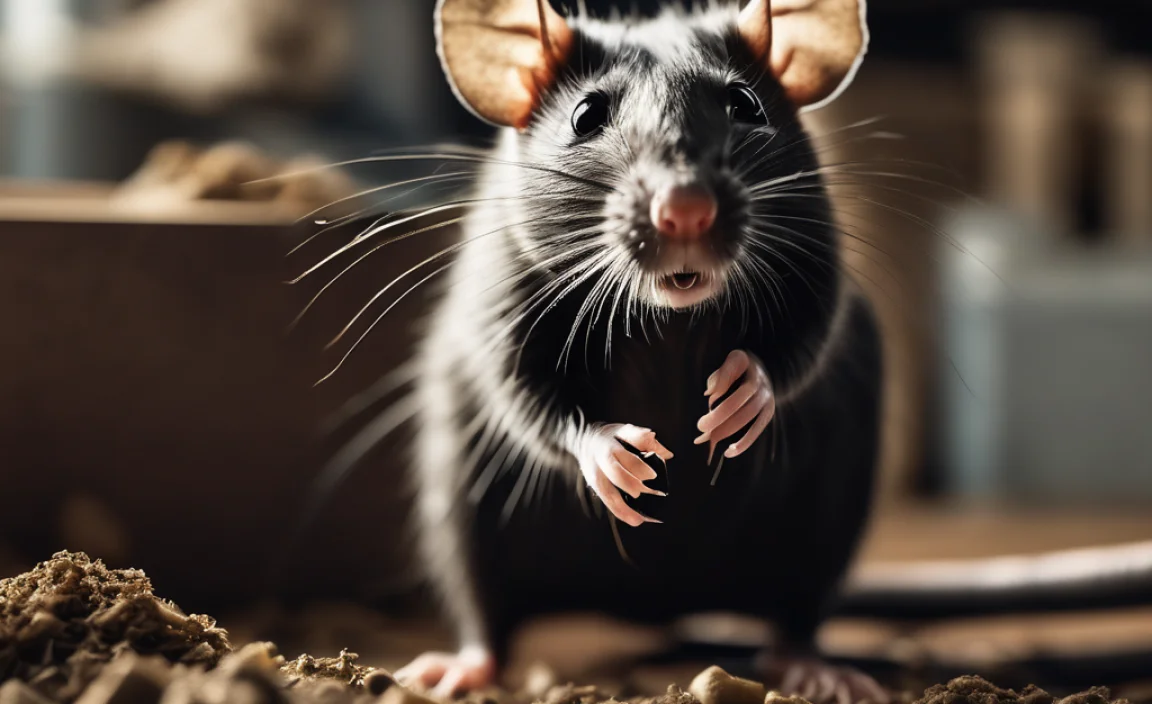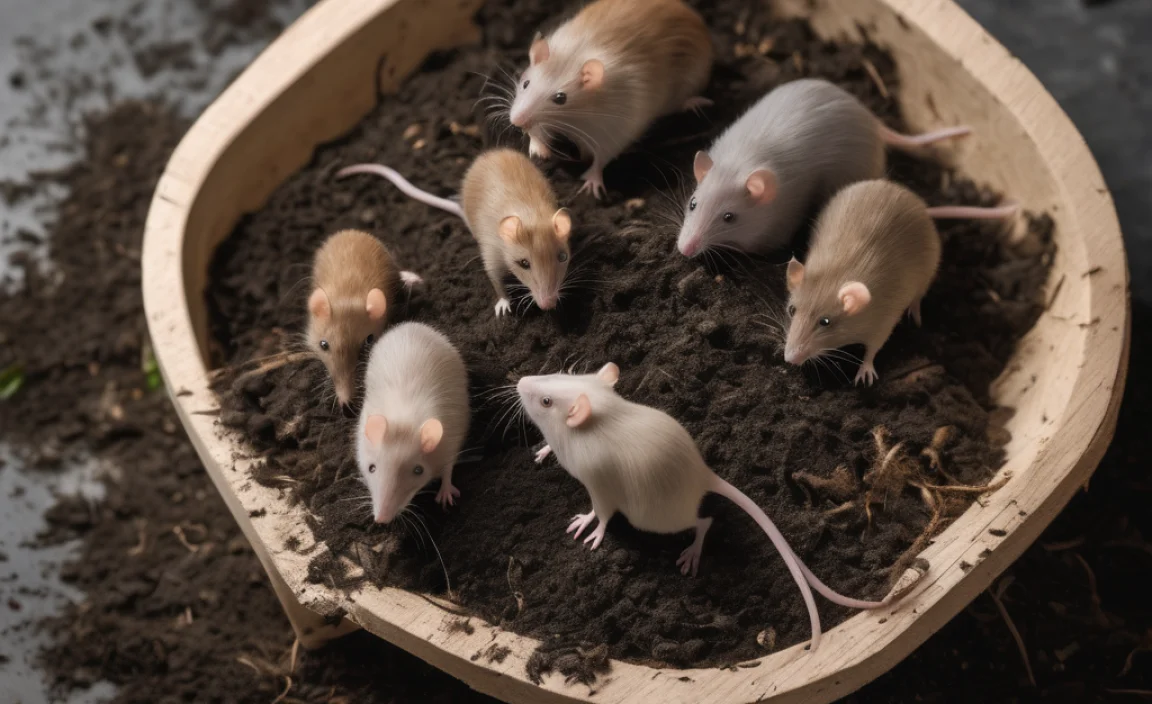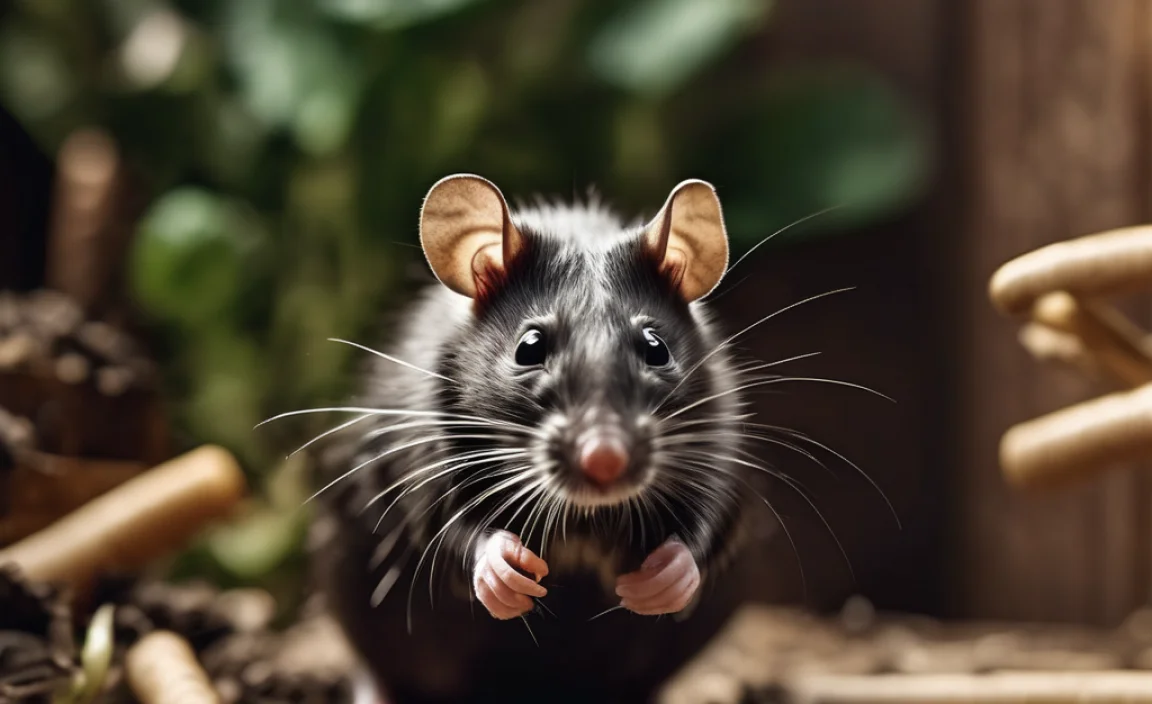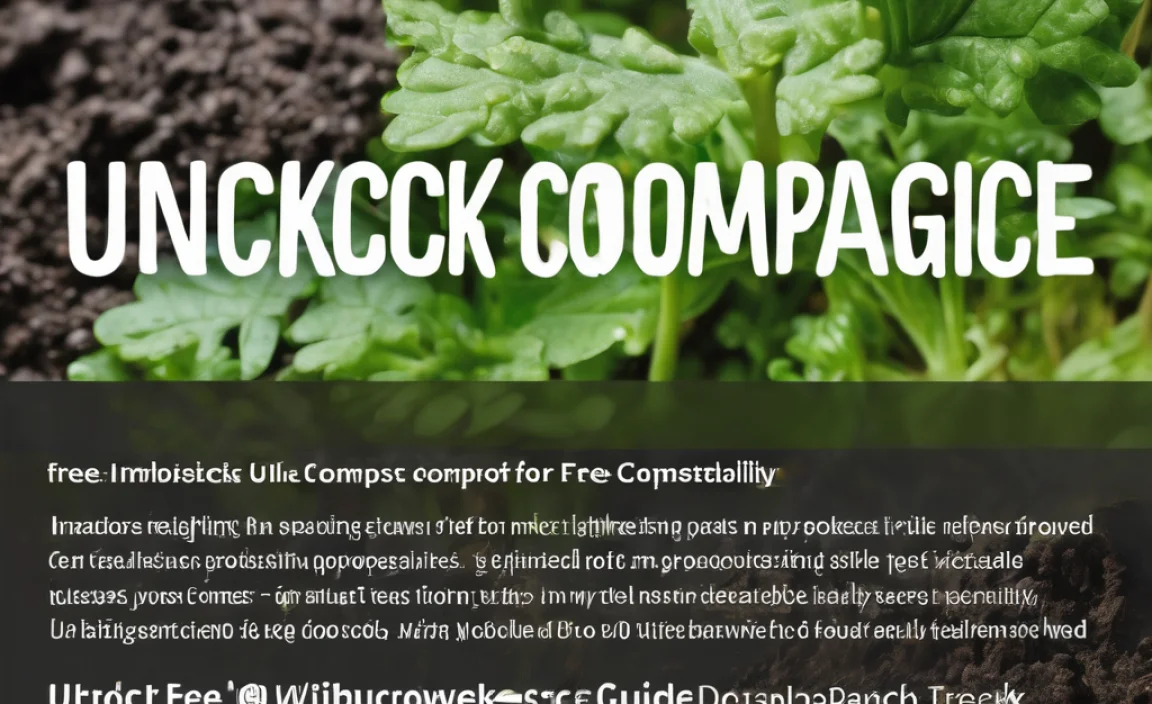Hey there! Ever wonder what’s really happening in your compost bin? It’s a whole universe of tiny helpers breaking down your scraps. But sometimes, bigger critters like rats might show up uninvited. Don’t worry, we can figure this out together! This guide will explain how compost microbes work and how to keep those unwanted guests away, so you can enjoy healthy compost the easy way.
Compost Microbes & Rats: Your Essential Beginner’s Guide
Composting is a fantastic way to reduce waste and create nutrient-rich soil for your garden. It’s powered by a hidden world of microorganisms – the compost microbes. These tiny workers are the true heroes of the compost pile, diligently transforming your kitchen scraps and yard waste into valuable garden gold. However, the rich, organic material in a compost bin can sometimes attract unwanted visitors, notably rats. Understanding how compost microbes function and how their environment can be managed, will help you create a thriving compost system that’s both effective and critter-free. We’ll break down everything you need to know, from the microscopic to the more noticeable, in simple, easy steps.
The Amazing World of Compost Microbes

Think of your compost pile as a bustling city for microscopic life. Billions of bacteria, fungi, actinomycetes, and other tiny organisms are on a mission: to decompose organic matter. These microbes are essential for turning what you might consider “waste” into nutrient-rich compost.
Meet the Microbe Team
Several types of microbes work together in your compost bin:
- Bacteria: These are the most numerous decomposers. They work in different temperature phases of composting, from the initial mesophilic (moderate temperature) phase to the thermophilic (high temperature) phase, and finally the curing (cooling) phase.
- Fungi: Fungi, including molds and yeasts, are fantastic at breaking down tougher materials like wood chips, leaves, and other fibrous organic matter that bacteria might struggle with.
- Actinomycetes: These are a type of filamentous bacteria that look a lot like fungi under a microscope. They’re responsible for that earthy, “clean dirt” smell of finished compost and help break down stubborn materials.
- Protozoa and Nematodes: These larger microbes play a role in consuming bacteria and fungi, helping to regulate populations and further break down materials.
How They Work Their Magic
Compost microbes need specific conditions to thrive and do their job effectively. These include:
- Food Source: They feed on the organic materials you add to the bin – food scraps, leaves, grass clippings, etc. A good mix of “greens” (nitrogen-rich, like food scraps) and “browns” (carbon-rich, like dead leaves) provides a balanced diet.
- Air (Oxygen): Most of the beneficial microbes are aerobic, meaning they need oxygen to survive and multiply. This is why turning or aerating your compost pile is crucial.
- Moisture: Microbes need water to live and move around. Compost should be as damp as a wrung-out sponge.
- Temperature: Different microbes work best at different temperatures. The composting process naturally heats up as microbes break down material, killing pathogens and weed seeds.
Why Rats Might Visit Your Compost Bin

Rats are opportunistic scavengers. If your compost bin offers a readily available food source and shelter, they might see it as a buffet or a cozy home. While we want the good microbes, we definitely don’t want our compost to become a rat hotel.
What Attracts Them?
- Easy Access to Food: This is the biggest draw. Piles of kitchen scraps, especially meat, dairy, or oily foods, are irresistible to rats.
- Uncovered or Poorly Contained Materials: If your compost bin has large openings or isn’t properly sealed, rats can easily get in.
- Presence of Water: Some rats might be attracted to the moisture source, especially in dry areas.
- Warmth and Shelter: A compost bin can provide a nice, insulated spot for rats to nest, particularly during colder months.
Keeping Rats Away from Your Compost: A Step-by-Step Approach

Don’t let the thought of rats put you off composting! With a few smart strategies, you can make your compost bin unappealing to them while still nurturing those essential microbes.
Step 1: Choose the Right Compost Bin
The type of bin you use makes a big difference.
- Enclosed Bins: These are generally the best for deterring pests. Look for bins with sturdy walls and secure lids. Many commercial compost bins are designed with this in mind.
- Hardware Cloth: If you’re building your own bin or using an open-style one, lining the inside or base with sturdy hardware cloth (1/4-inch mesh or smaller) is highly effective. This allows air and water through but keeps rats out.
- Tumblers: Compost tumblers are often a good choice because they are fully enclosed and can be elevated, making them harder for ground-dwelling pests to access.
Step 2: What to Compost (and What to Avoid)
This is super important for making your compost less attractive to rats.
What to Compost (Greens & Browns):
- Fruit and vegetable scraps
- Coffee grounds and tea bags
- Eggshells
- Grass clippings (in moderation)
- Leaves
- Shredded newspaper and cardboard
- Straw and hay
- Sawdust (from untreated wood)
What to AVOID if Rats are a Concern:
- Meat, fish, and bones: These are highly attractive to rodents and can also attract other unwanted pests.
- Dairy products: Cheese, milk, yogurt, etc., also draw in rats and can create odors.
- Oily and greasy foods: Including fats, cooking oils, and butter.
- Diseased plants: While not a rodent attractant, they can spread disease in your garden if not composted at high temperatures.
- Pet waste: Dog and cat feces can carry pathogens and are generally not recommended for home compost unless you have a specialized system for high-temperature composting.
Step 3: Maintain a Healthy Compost Pile
A well-managed compost pile is less welcoming to pests and works better!
- Balance Greens and Browns: Aim for a ratio of roughly 2-3 parts browns to 1 part greens. This balance creates a healthy environment for microbes and can help the pile heat up.
- Keep it Moist: Your compost should feel like a damp sponge. Too dry, and the microbes slow down. Too wet, and it can become anaerobic and smelly, which might attract pests.
- Aerate Regularly: Turning your compost pile every week or two with a pitchfork or compost aerator is key. This provides oxygen for aerobic microbes, speeds up decomposition, and helps generate heat. Hot composting (reaching temperatures of 130-160°F or 54-71°C) is a natural pest deterrent. For more on hot composting, the U.S. Environmental Protection Agency (EPA) offers great resources.
- Bury Food Scraps: When adding kitchen scraps, try to bury them deep within the pile, away from the edges. This makes them less accessible and visible to pests.
Step 4: Proper Location and Maintenance
Where you put your compost bin and how you maintain the area around it matters.
- Elevate Your Bin: If possible, place your compost bin on a raised platform or ensure the base is well-secured with hardware cloth. This makes it harder for burrowing animals to get underneath or into.
- Avoid Placing Near Structures: Don’t put your compost bin right next to your house, shed, or deck, as rats can use these structures for cover and easy access to the bin.
- Keep the Area Clean: Regularly clear away any spilled compost or food debris from around the bin. Overgrown vegetation nearby can also provide hiding places for rodents.
- Cover Fresh Additions: After adding kitchen scraps, cover them with a layer of “browns” like leaves or shredded cardboard.
Step 5: Troubleshooting and Prevention
Sometimes, despite your best efforts, you might see signs of rats. Here’s what to do:
- Rodent-Proofing: If you have persistent issues, consider reinforcing your bin with stronger mesh or ensuring the lid is always closed tightly.
- Seal Any Gaps: Check your bin for any holes or gaps larger than 1/2 inch and seal them.
- Avoid Attracting Them Elsewhere: Make sure other food sources, like pet food left out or bird feeders that spill, are not readily available to rats.
- Natural Deterrents (Use with Caution): Some people use strong-smelling substances like peppermint oil or ammonia-soaked rags around the base of the bin. However, these methods are generally less effective and don’t address the root cause (food source).
- For Persistent Problems: If rodent issues are severe and cannot be controlled with these methods, you might need to consider more direct pest control measures, but this should be a last resort and done safely. Research humane traps or professional advice if necessary.
Compost Microbes vs. Rats: A Quick Comparison

It’s helpful to see how the ideal conditions for microbes and the things that attract rats can sometimes clash, and how to balance them.
| Aspect | Ideal for Compost Microbes | Attracts Rats | How to Manage |
|---|---|---|---|
| Food Source | Balanced mix of greens and browns (starches, sugars, proteins, fats) | Meat, dairy, oily foods, easily accessible scraps | Avoid prohibited items, bury food scraps, use enclosed bins. |
| Moisture | Damp but not saturated (like a wrung-out sponge) | Standing water, overly wet material | Ensure good drainage, don’t overwater, turn pile. |
| Air/Oxygen | Plenty of air (aerobic microbes) | Stagnant, smelly conditions can sometimes attract opportunists. | Turn pile regularly, use breathable bin materials. |
| Temperature | Heats up significantly during thermophilic phase (130-160°F / 54-71°C) | Warm, sheltered spots appeal to rats for nesting. | Maintain a balanced compost mix, turn pile to ensure even heating. |
| Structure/Shelter | Decomposing organic matter | Easy access, burrows, undisturbed piles | Use enclosed bins, hardware cloth, keep surrounding area clear. |
Composting Hot vs. Cold: A Note on Pest Control

Composting can be done through “hot” or “cold” methods. Understanding the difference helps with pest management.
- Hot Composting: This method involves carefully balancing green and brown materials, maintaining proper moisture, and turning the pile frequently to introduce oxygen. The goal is to get the pile to heat up significantly (130-160°F / 54-71°C). This high heat kills weed seeds and pathogens. Critically, this intense heat also makes the pile very uninviting and often lethal to pests like rat eggs and larvae, making hot composting a natural form of rodent deterrence.
- Cold Composting: This is a more passive approach where you simply add materials to a pile or bin and let them decompose slowly over time. Cold piles generally don’t reach high temperatures. While it’s easier, cold compost piles are much more likely to attract rodents and other pests because they offer a consistent, undisturbed food source without the discouraging element of high heat. Materials also take much longer to break down.
For beginners concerned about rats, aiming for a “hot” or at least a “warm” composting process is recommended, especially by using enclosed bins and avoiding rodent-attracting food scraps. If you’re doing cold composting, you absolutely must ensure your bin is rodent-proofed with hardware cloth and a secure lid.
Conclusion
Composting is a rewarding process that relies on the tireless work of compost microbes. By understanding their needs and also what makes compost bins attractive to less desirable visitors like rats, you can create a system that works brilliantly. Remember, the goal is a balanced, well-aerated, and appropriately moist pile. By choosing a secure bin, avoiding problematic food scraps, and managing your pile diligently, you can ensure that your compost pile buzzes with beneficial microbes, not scurrying rodents. Happy composting!
Frequently Asked Questions (FAQs)
Here are some questions I often hear from folks getting started:
Q1: Can rats actually eat my compost?
A: Yes, rats are attracted to the organic matter in compost, especially if you include items like meat, dairy, or oily foods. They can dig into the compost to eat these materials.
Q2: Will hot composting kill rats?
A: While hot composting aims to reach temperatures that kill pathogens and weed seeds (130-160°F / 54-71°C), it’s unlikely to directly kill adult rats inside the pile. However, the extreme heat creates an environment they generally avoid. It’s more effective at deterring them and killing their eggs or larvae.
Q3: My compost pile smells bad and has rats. What’s wrong?
A: A smelly compost pile, especially one that smells like ammonia or rotten eggs, usually means it’s too wet, lacks oxygen, or has too many “greens.” These conditions are less ideal for beneficial microbes and can attract opportunistic pests like rats. Try turning the pile, adding more “browns” (like shredded paper or leaves), and ensuring good drainage.
Q4: Is it safe to compost my food scraps if rats are a problem in my neighborhood?
A: Yes, it’s still safe and beneficial to compost food scraps, but you need to be more vigilant. The key is to use a rodent-proof bin (like an enclosed tumbler or a bin lined with hardware cloth) and strictly avoid composting meat, dairy, and oily foods. Burying food scraps deep within the pile also helps.
Q5: How do I know if I have rats in my compost? Should I be worried?
A: Signs of rats include droppings (small, dark pellets), gnaw marks on the bin or materials, visible burrows near or in the bin, and actual sightings of rats. While it’s undesirable, it doesn’t mean you have to stop composting. It just means you need to take extra steps for pest-proofing.
Q6: What’s the best type of compost bin to keep rats out?
A: Fully enclosed compost tumblers and sturdy, plastic compost bins with tight-fitting lids are generally the most effective at keeping rats out. For DIY bins or open compost piles, lining them with 1/4-inch or smaller hardware cloth is crucial.
.lwrp.link-whisper-related-posts{
margin-top: 40px;
margin-bottom: 30px;
}
.lwrp .lwrp-title{
}.lwrp .lwrp-description{
}
.lwrp .lwrp-list-container{
}
.lwrp .lwrp-list-multi-container{
display: flex;
}
.lwrp .lwrp-list-double{
width: 48%;
}
.lwrp .lwrp-list-triple{
width: 32%;
}
.lwrp .lwrp-list-row-container{
display: flex;
justify-content: space-between;
}
.lwrp .lwrp-list-row-container .lwrp-list-item{
width: calc(25% – 20px);
}
.lwrp .lwrp-list-item:not(.lwrp-no-posts-message-item){
max-width: 150px;
}
.lwrp .lwrp-list-item img{
max-width: 100%;
height: auto;
object-fit: cover;
aspect-ratio: 1 / 1;
}
.lwrp .lwrp-list-item.lwrp-empty-list-item{
background: initial !important;
}
.lwrp .lwrp-list-item .lwrp-list-link .lwrp-list-link-title-text,
.lwrp .lwrp-list-item .lwrp-list-no-posts-message{
}@media screen and (max-width: 480px) {
.lwrp.link-whisper-related-posts{
}
.lwrp .lwrp-title{
}.lwrp .lwrp-description{
}
.lwrp .lwrp-list-multi-container{
flex-direction: column;
}
.lwrp .lwrp-list-multi-container ul.lwrp-list{
margin-top: 0px;
margin-bottom: 0px;
padding-top: 0px;
padding-bottom: 0px;
}
.lwrp .lwrp-list-double,
.lwrp .lwrp-list-triple{
width: 100%;
}
.lwrp .lwrp-list-row-container{
justify-content: initial;
flex-direction: column;
}
.lwrp .lwrp-list-row-container .lwrp-list-item{
width: 100%;
}
.lwrp .lwrp-list-item:not(.lwrp-no-posts-message-item){
max-width: initial;
}
.lwrp .lwrp-list-item .lwrp-list-link .lwrp-list-link-title-text,
.lwrp .lwrp-list-item .lwrp-list-no-posts-message{
};
}

I am passionate about home engineering. I specialize in designing, installing, and maintaining heating, ventilation, and air conditioning systems. My goal is to help people stay comfortable in their homes all year long.

